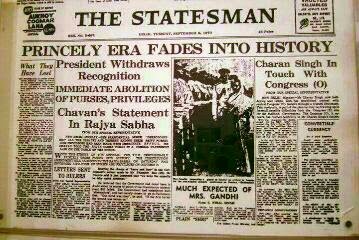The case of privy purse considered as one of the most important cases where court upheld the rights of rulers of former princely states when government tried to snatch the privileges and pension of the rulers to further strengthen the idea of democracy in India and to create an equal society without hierarchy.
Background of the case
On September 6, 1970, the President of India passed a laconic order in respect of each of the Rulers of former Indian States. The order was served by a Secretary to Government of India. A sample order issued to the Ruler of Gwalior State may be read here:
ORDER
“In exercise of the power vested in him under Article 366(22) of the Constitution, the President hereby directs that with effect from the date of this Order His Highness Maharajdhiraja Madhav Rao Jiwaji Rao Scindia Bahadur do cease to be recognised as the Ruler of Gwalior.
By order and in the name of the President.
Sd./”

All these orders were notified together in the Gazette of India of September 19, 1970, Part II. They resulted in the forthwith stoppage of the Privy Purses received by the Rulers and the discontinuance of their personal privileges.
The institution of the case
Against the order of government, a writ petition was filed by the ruler of guwalior under Article 32 of Constitution of India to enforce the fundamental rights. With him, some other rulers also filed the petition.
They asked for a writ, direction or order,
- declaring the Presidential Order to be unconstitutional, mala fide, ultra vires and void, and for quashing it,
- declaring that the several petitioners continue to be Rulers and thus to be entitled to their respective Privy Purses and personal rights and privileges and
- directing the Union of India to continue to ‘pay the Privy Purses as before and to recognise the personal rights to privileges and to observe the, provisions of the Covenants and Merger Agreements.
They claimed that Government was prevented by promissory estoppel and had acted in breach of a fiduciary duty. But the government in respond said that The Privy Purse itself being-in the nature of a political pension, a claim to it was not property and no claim could arise if it was stopped.
All petitions Merged
Since the issues involved in all the petitions were common and there were only minor differences in the steps before the States merged with the Indian Union, the court merged the petition and refer the petition of Ruler of Gwalior which was first on the list and embraced almost all the varying aspects of the question.
The other petitions were identical except for some details which are special to a particular Ruler but were not material for the discussion of the issues involved.
Instrument of Accession of the Ruler of Gwalior
Princely states were merged to Union of India through an ‘Instrument of accession’ accepted by each ruler. Therefore, in the present case, instrument of accession was of very importance.
The Instruments of Accession were executed in furtherance of the Indian Independence Act, 1947. On June 3, 1947 the British Government announced their plan of transfer of power in India. The Government of India formed a Ministry of States under Sardar Vallabhbhai Patel and it was decided to secure the accession of Indian States on three subjects: External Affairs; and Communications.
The Act provided for lapse of sovereignty of the British Crown in India over the Indian States` and they were free to accede to any of the two Dominions of India or Pakistan or to continue as independent sovereigns.
In furtherance of these new provisions, the Instruments of Accession were executed on different dates, after negotiations between the Government of India and the Rulers, but nothing turns upon the date of an Instrument.
The Ruler of the Gwalior (Madhav Rao Scindia) State succeeded to the gaddi of the State on July 16, 1961 on the demise of his father. On August 15, 1947 the father had signed an Instrument of Accession of his state to the Dominion of India, as then established, and it was accepted by the Governor-General of India on the following day. This Instrument of Accession was similar to those which the other Rulers signed on diverse dates.
In the Preamble to the Instrument the Ruler observed that he was executing it in the exercise of his sovereignty in and over his State. He declared that he was acceding to the Dominion of India and authorised the Governor-General of India, the Dominion Legislature, the Federal Court and any other Dominion Authority established for the purposes of the Dominion to exercise in relation to hi-, State functions vested in them by or under the Government of India Act 1935 as in force on the 15th August 1947.
On his part he undertook the obligation of ensuring that effect was given to the provisions of the Government of India Act 1935 in his State. He accented that the Dominion Legislature would make law, with respect to matters specified in the Schedule to his Instrument.
In 1970, the government snatched away the privy purse of the rulers, in consequence thereof the ruler filed petition to the supreme court where supreme court upheld the rights of rulers, however after that, government brought 26th amendment and abolished the privy purses.
